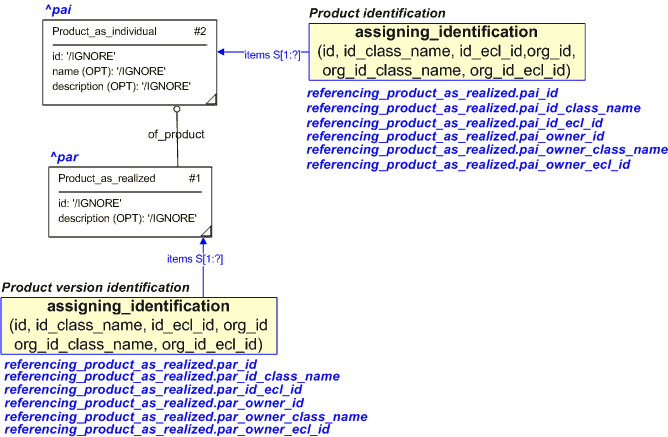Template:— referencing_product_as_realized (ref_prod_real)
Capability:representing_product_as_individual |
Date: 2007/09/28 12:44:06
Revision: 1.6
|
This section specifies the template referencing_product_as_realized.
NOTE
The template has been defined in the context of the capability
representing_product_as_individual
which provides an overall description of the
relevant parts of the ISO 10303-239 information model and a description
of related templates.
NOTE
An explanation of a template and the associated instantiation path is
provided in the
Template overview
section.
This template describes how to relate and identify product_as_individual with a version of product_as_realized.
The EXPRESS-G diagram in
Figure
1
shows the templates and EXPRESS entities that are required
to represent the template
"referencing_product_as_realized".
The text highlighted in blue shows the template parameters.
...
Figure 1 — An EXPRESS-G representation of the Information model for referencing_product_as_realized
The graphic for the template to be used in other EXPRESS-G diagrams
is shown in Figure
2
below.
...
Figure 2 — The graphical representation of the referencing_product_as_realized template
The following input parameters are defined for this template:
The identifier of the Product_as_individual, e.g. serial number.
The name of the class being used to classify the identification
(
Identification_assignment)
of the individual product. This provides the role or reason for the identification.
The following classes and their sub-classes can be used:
id_ecl_id (Default=urn:plcs:rdl:std,Type='URN')
The identifier of the
External_class_library
storing the definition of the class referenced by the parameter @id_class_name class.
The name or identifier of the organization owning the id or name.
The name of the class being used to classify the
identification of the organization. For example CAGE code, or organization name.
The following classes and their sub-classes can be used:
par_id (Default=Unknown,Type='STRING')
The identifier of the Product_as_realized, e.g. version marking, modification status.
The name of the class being used to classify the identification
(
Identification_assignment)
of the product_as_realized (a version of the individual product). This provides the role or reason for the identification.
The following classes and their sub-classes can be used:
The identifier of the
External_class_library
storing the definition of the class referenced by the parameter @par_id_class_name class.
The name or identifier of the organization owning the version_id.
The name of the class being used to classify the
identification of the organization. For example CAGE code, or organization name.
The following classes and their sub-classes can be used:
The following reference parameters are defined for this template:
Allow the
Product_as_individual
entity instantiated in this path to be referenced when this template is used.
%^target = $referencing_product_as_realized.pai%
Allow the
Product_as_realized
entity instantiated in this path to be referenced when this template is used.
%^target = $referencing_product_as_realized.par%
The instantiation path shown below specifies the entities that are to be
instantiated by the template.
A description of templates and the syntax for the instantiation path is
provided in the
Templates Help/Information section.
-- instantiate Product_as_individual Product_as_individual%^pai =
Product_as_individual%
^pai.id = '/IGNORE'
^pai.name = '/IGNORE'
^pai.description = '/IGNORE'
-- assign ID to individual /
assigning_identification(
id=@id,
id_class_name=@id_class_name,
id_ecl_id=@id_ecl_id,
org_id=@owner_id,
org_id_class_name=@owner_class_name,
org_id_ecl_id=@owner_ecl_id,
items=^pai)/
-- instantiate Product_as_realized Product_as_realized%^par =
Product_as_realized%
^par.id = '/IGNORE'
^par.description = '/IGNORE'
^par.of_product ->
^pai
-- assign ID to Product_as_realized /
assigning_identification(
id=@par_id,
id_class_name=@par_id_class_name,
id_ecl_id=@par_id_ecl_id,
org_id=@par_owner_id,
org_id_class_name=@par_owner_class_name,
org_id_ecl_id=@par_owner_ecl_id,
items=^par)/
The following entities are instantiated with attributes as specified:
The instance diagram in Figure
3
shows an example of the EXPRESS entities and templates that are instantiated by the template:
/referencing_product_as_realized(id='12376588', id_class_name='Serial_identification_code', id_ecl_id='urn:plcs:rdl:std', id_owner='Crescent', id_owner_class_name='Organization_name', id_owner_ecl_id='urn:plcs:rdl:std', par_id='Mod1', par_id_class_name='Version_identification_code', par_id_ecl_id='urn:plcs:rdl:std', par_owner='Express Delivery Inc', par_owner_class_name='Organization_name', par_owner_ecl_id='urn:plcs:rdl:std')/
(an illustration of the consolidated referencing_product_as_realized template is shown in
Figure
4 below.)
Figure 3 — Entities instantiated by referencing_product_as_realized template
The instance diagram in
Figure
4
shows the graphic symbol for the template that is to be
used in other instance diagrams. The example template is:
/referencing_product_as_realized(id='12376588', id_class_name='Serial_identification_code', id_ecl_id='urn:plcs:rdl:std', id_owner='Crescent', id_owner_class_name='Organization_name', id_owner_ecl_id='urn:plcs:rdl:std', par_id='Mod1', par_id_class_name='Version_identification_code', par_id_ecl_id='urn:plcs:rdl:std', par_owner='Express Delivery Inc', par_owner_class_name='Organization_name', par_owner_ecl_id='urn:plcs:rdl:std')/
Figure 4 — Instantiation of referencing_product_as_realized template
Characterizations
No common characterizations of the template
referencing_product_as_realized
have been identified. However, the ISO 10303-239 EXPRESS model
may enable other assignments to the entities instantiated by the template.




